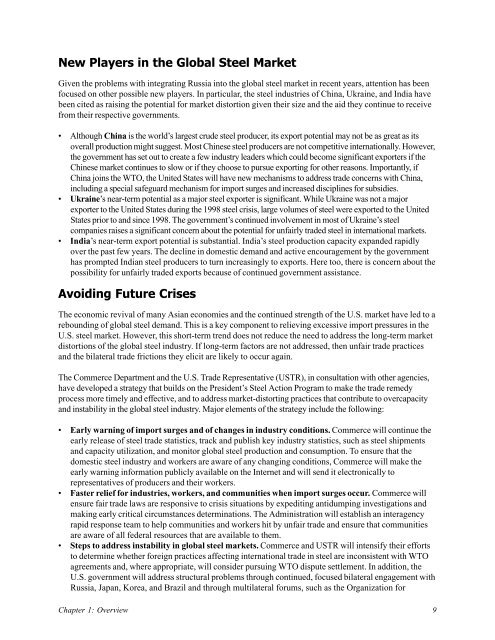Global Steel Trade; Structural Problems and Future Solutions
Global Steel Trade; Structural Problems and Future Solutions
Global Steel Trade; Structural Problems and Future Solutions
Create successful ePaper yourself
Turn your PDF publications into a flip-book with our unique Google optimized e-Paper software.
New Players in the <strong>Global</strong> <strong>Steel</strong> Market<br />
Given the problems with integrating Russia into the global steel market in recent years, attention has been<br />
focused on other possible new players. In particular, the steel industries of China, Ukraine, <strong>and</strong> India have<br />
been cited as raising the potential for market distortion given their size <strong>and</strong> the aid they continue to receive<br />
from their respective governments.<br />
• Although China is the world’s largest crude steel producer, its export potential may not be as great as its<br />
overall production might suggest. Most Chinese steel producers are not competitive internationally. However,<br />
the government has set out to create a few industry leaders which could become significant exporters if the<br />
Chinese market continues to slow or if they choose to pursue exporting for other reasons. Importantly, if<br />
China joins the WTO, the United States will have new mechanisms to address trade concerns with China,<br />
including a special safeguard mechanism for import surges <strong>and</strong> increased disciplines for subsidies.<br />
• Ukraine’s near-term potential as a major steel exporter is significant. While Ukraine was not a major<br />
exporter to the United States during the 1998 steel crisis, large volumes of steel were exported to the United<br />
States prior to <strong>and</strong> since 1998. The government’s continued involvement in most of Ukraine’s steel<br />
companies raises a significant concern about the potential for unfairly traded steel in international markets.<br />
• India’s near-term export potential is substantial. India’s steel production capacity exp<strong>and</strong>ed rapidly<br />
over the past few years. The decline in domestic dem<strong>and</strong> <strong>and</strong> active encouragement by the government<br />
has prompted Indian steel producers to turn increasingly to exports. Here too, there is concern about the<br />
possibility for unfairly traded exports because of continued government assistance.<br />
Avoiding <strong>Future</strong> Crises<br />
The economic revival of many Asian economies <strong>and</strong> the continued strength of the U.S. market have led to a<br />
rebounding of global steel dem<strong>and</strong>. This is a key component to relieving excessive import pressures in the<br />
U.S. steel market. However, this short-term trend does not reduce the need to address the long-term market<br />
distortions of the global steel industry. If long-term factors are not addressed, then unfair trade practices<br />
<strong>and</strong> the bilateral trade frictions they elicit are likely to occur again.<br />
The Commerce Department <strong>and</strong> the U.S. <strong>Trade</strong> Representative (USTR), in consultation with other agencies,<br />
have developed a strategy that builds on the President’s <strong>Steel</strong> Action Program to make the trade remedy<br />
process more timely <strong>and</strong> effective, <strong>and</strong> to address market-distorting practices that contribute to overcapacity<br />
<strong>and</strong> instability in the global steel industry. Major elements of the strategy include the following:<br />
• Early warning of import surges <strong>and</strong> of changes in industry conditions. Commerce will continue the<br />
early release of steel trade statistics, track <strong>and</strong> publish key industry statistics, such as steel shipments<br />
<strong>and</strong> capacity utilization, <strong>and</strong> monitor global steel production <strong>and</strong> consumption. To ensure that the<br />
domestic steel industry <strong>and</strong> workers are aware of any changing conditions, Commerce will make the<br />
early warning information publicly available on the Internet <strong>and</strong> will send it electronically to<br />
representatives of producers <strong>and</strong> their workers.<br />
• Faster relief for industries, workers, <strong>and</strong> communities when import surges occur. Commerce will<br />
ensure fair trade laws are responsive to crisis situations by expediting antidumping investigations <strong>and</strong><br />
making early critical circumstances determinations. The Administration will establish an interagency<br />
rapid response team to help communities <strong>and</strong> workers hit by unfair trade <strong>and</strong> ensure that communities<br />
are aware of all federal resources that are available to them.<br />
• Steps to address instability in global steel markets. Commerce <strong>and</strong> USTR will intensify their efforts<br />
to determine whether foreign practices affecting international trade in steel are inconsistent with WTO<br />
agreements <strong>and</strong>, where appropriate, will consider pursuing WTO dispute settlement. In addition, the<br />
U.S. government will address structural problems through continued, focused bilateral engagement with<br />
Russia, Japan, Korea, <strong>and</strong> Brazil <strong>and</strong> through multilateral forums, such as the Organization for<br />
Chapter 1: Overview 9
















